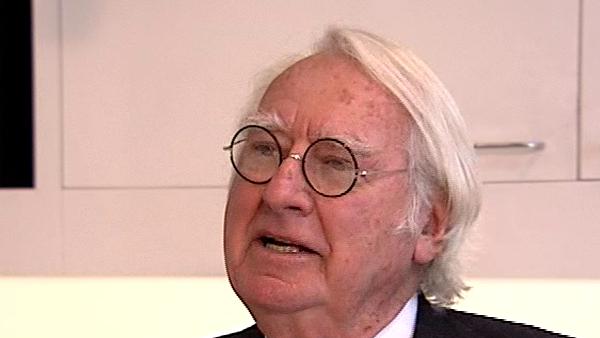NEXT STORY

The birth of a project
RELATED STORIES

NEXT STORY

The birth of a project
RELATED STORIES


|
Views | Duration | |
|---|---|---|---|
| 21. Conscious modern building | 217 | 02:56 | |
| 22. The pleasure of creating public spaces | 159 | 05:30 | |
| 23. The importance of the public spaces within a building | 236 | 01:12 | |
| 24. The Neugebauer House | 472 | 04:45 | |
| 25. Light and white | 413 | 02:35 | |
| 26. Building in context | 237 | 03:29 | |
| 27. The birth of a project | 212 | 01:27 | |
| 28. My design process | 1 | 516 | 01:11 |
| 29. The New York Five | 363 | 03:46 | |
| 30. Changes in the architectural community | 125 | 03:29 |


Earlier we talked about, you know, why am I so popular in Germany, for instance. Well, I don’t know, if I’m that popular in Germany but in any event. In any event because I think that starting with the... the Frankfurt Museum and with other projects that are there as well, Ulm, Weishaupt, Siemens... going on and on, what people have reacted to was in working in these historical centers, the new building is not a pastiche. It doesn’t try to replicate, you know, what was there and what is there. It talks about our time. It talks about what can be but it deals with human scale and it’s really that human scale experience of the building, the surroundings, the relationship between the building and what’s around it that makes it what... what’s important. And it shows you that, you know, modern architecture, you know, is not alienating. It’s as inviting as historical buildings if the human scale of the quality of the experience of moving through the building is... the people can relate to. And I think that’s what... what it’s about and also the sense of public space, which is so much a part of the experience of most European cities, you know. Public space is where people come together in different ways. Whether its in the cafés, around the squares but there’s a sense of public space in European villages, and towns and cities that we don’t have here. We have no; we have no recognition of it. We have no, and that’s why some of the emerging areas of New York City are so extraordinary. You go down the Lower Eastside, you see the number of people out on the street, cafés and the life on the street where people come together. It’s always on the street but nevertheless they’re... it’s a creation of a place even though it’s a streetlife but we have no small squares or public spaces. Our public spaces are Central Park and Rockefeller Center, that’s it.
[Q] Now, sometime you also do contextual relationship in proportions, alignments...
Well, where it’s appropriate, I think that, you know, you can find elements within the context that you can incorporate in the design because it’s a cornice line, you don’t have to express it as a cornice, but it may be a way of a plane stopping in relation, you know, to that line that seems to run around it. In Ulm, the skylights don’t replicate the hip roofs but they make reference to it and yet are fresh and abstract.
The prominent American architect Richard Meier (b. 1934) is best known for the Getty Centre in Los Angeles, one of his many public projects which broke from his usual style of sleek, white buildings. In all his work – carried out with characteristic refined style – he refuses to bend to the trends of modern architecture. He has won many awards including the Pritzker Prize for Architecture, considered the field's highest honour.
Title: Building in context
Listeners: Massimo Vignelli
Massimo Vignelli was born in Milan and studied architecture in Milan and Venice. He is the co-founder and President of Vignelli Associates and Chief Executive Officer of Vignelli Designs in New York. His work includes graphic and corporate identity programs, publication designs, architectural graphics, interiors, furniture, and consumer product designs. His work has been published and exhibited throughout the world and entered in the permanent collections of several museums. He has taught and lectured on design in the major cities and universities in the United States and abroad. Included among Massimo Vignelli's awards are the Gran Premio Triennale di Milano, 1964, the Compasso d'Oro, awarded by the Italian Association for Industrial Design (ADI), 1964 and 1998, the 1982 Art Directors Club Hall of Fame, the 1983 AIGA Gold Medal, the 1992 Interior Product Designers Fellowship of Excellence, The 1995 Brooklyn Museum Design Award for Lifetime Achievement and The 2001 Russel Wright Award for Design Excellence.
Duration: 3 minutes, 29 seconds
Date story recorded: March 2007
Date story went live: 23 December 2008